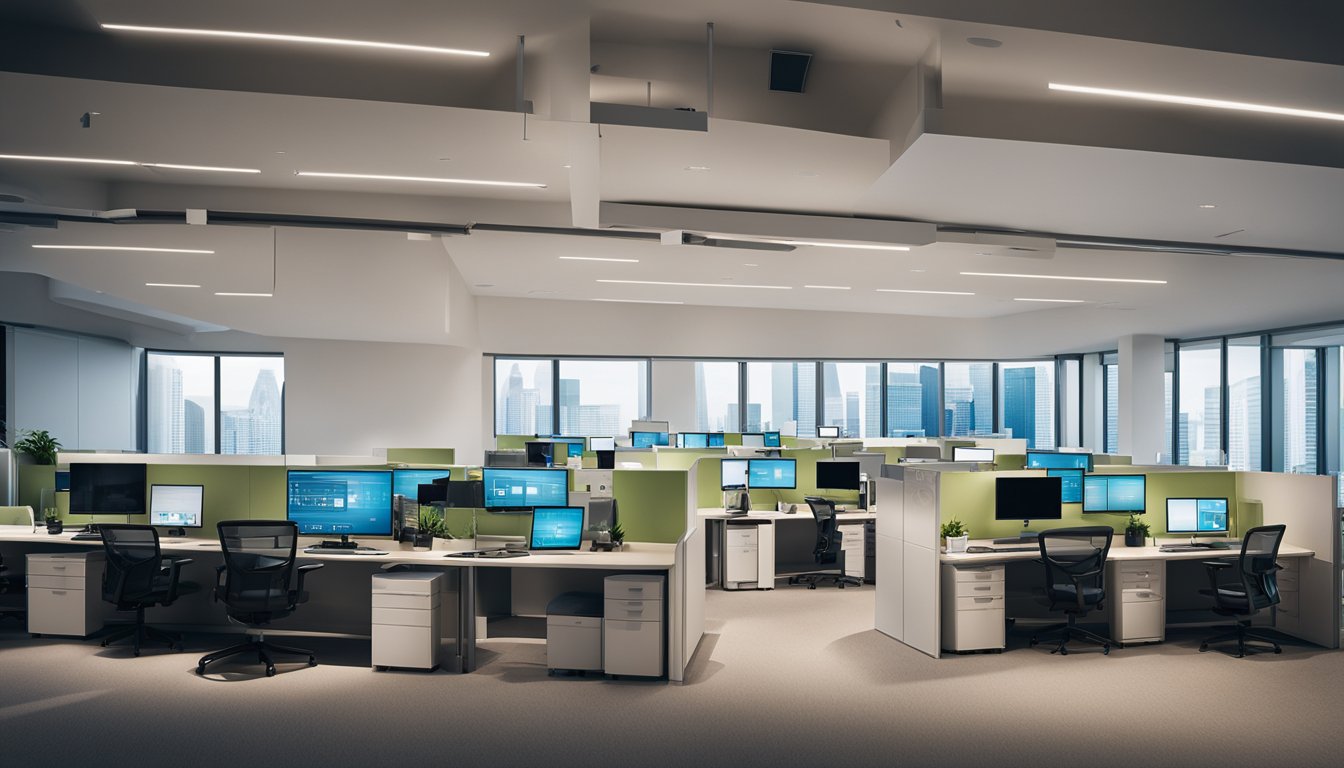Late updated: 05 Aug 2024 13:08
Written by: Amber Collins
Optimising Energy Use With Smart Office Technologies: Efficient Workspaces for a Sustainable Future
In our rapidly evolving world of work, the need for energy optimization in office environments has become more critical than ever. With the advent of smart office technologies, we are now empowered to create intelligent, connected workplaces that significantly reduce energy consumption. By harnessing advanced sensors and data analytics, these systems learn user behaviour patterns and automate processes to ensure peak energy efficiency. Not only does this approach support sustainability goals, but it also enhances productivity and safety, offering a double benefit to businesses.

Smart office solutions employ a variety of technologies, from IoT sensors to comprehensive energy management systems. These tools monitor and control energy usage, ensuring that resources are not wasted. The result is a finely tuned environment that meets the unique needs of its users while keeping operational costs in check. As we delve deeper into the specifics, it becomes evident that the adoption of these systems is not just an option but a necessity for modern workspaces aiming for efficiency and sustainability.
The economic and environmental impacts of adopting smart office technologies can't be overstated. Companies that implement these solutions see a marked decrease in their energy bills and a reduced carbon footprint. This aligns with global sustainability goals and demonstrates a commitment to corporate responsibility. As we explore further, we'll address common questions and provide insights into how these technologies can be seamlessly integrated into existing office infrastructures.
Key Takeaways
- Smart office technologies significantly optimise energy use.
- IoT sensors and data analytics play crucial roles in energy management.
- Implementing these systems can lead to substantial cost savings and environmental benefits.
Core Smart Office Technologies

In integrating smart office technologies for energy optimisation, we focus on four primary areas: intelligent building automation systems, energy management systems, smart lighting, and optimised HVAC systems.
Intelligent Building Automation Systems (BAS) and IoT
Intelligent Building Automation Systems (BAS) utilise the Internet of Things (IoT) to achieve an interconnected and efficient workspace. IoT devices, equipped with various sensors, monitor and control building functions.
These systems can automate processes like lighting, security, and environmental controls, ensuring optimal energy use. Leveraging AI technology and data analytics, these automation systems learn from patterns in user behaviour. This allows them to adjust settings in real time, reducing unnecessary energy consumption and enhancing overall building efficiency.
Benefits:
- Enhanced energy efficiency
- Improved security and safety
- Cost savings through reduced energy waste
Key Components:
- IoT sensors
- AI-powered analytics
- Automated control systems
Energy Management Systems and Data Analytics
Energy Management Systems (EMS) are crucial in tracking and optimising energy usage. These systems collect data from various sensors installed throughout the office environment. The data analytics process then helps to identify patterns and inefficiencies.
By using advanced data analytics, we can pinpoint areas where energy use can be reduced without impacting productivity. These insights enable us to make informed decisions about energy-saving measures. For example, EMS might suggest adjustments to HVAC settings or recommend times for reducing lighting levels based on occupancy trends.
Core Functions:
- Real-time energy monitoring
- Data-driven insights
- Customised energy-saving strategies
Benefits:
- Reduced operational costs
- Lower carbon footprint
- Enhanced sustainability
Smart Lighting and Control Systems
Smart lighting solutions significantly contribute to energy optimisation. These systems employ sensors that detect occupancy and natural light levels to adjust artificial lighting accordingly. This not only saves energy but also improves the lighting quality and user comfort.
Advanced lighting controls can integrate with automated blinds to maximise the use of natural light. Moreover, scheduling features allow lights to be turned off or dimmed during non-peak hours. Implementing smart lights reduces the need for constant manual adjustments, ensuring spaces are lit efficiently based on current needs.
Features:
- Occupancy sensors
- Automated dimming
- Integration with natural light controls
Advantages:
- Energy savings
- Increased comfort
- Enhanced workspace aesthetics
HVAC Systems Optimisation
Heating, Ventilation, and Air Conditioning (HVAC) systems are some of the largest consumers of energy in office buildings. Optimising these systems through smart technology can lead to significant energy savings. Sensors and IoT devices monitor temperature, humidity, and occupancy levels.
These systems can then adjust heating and cooling processes to maintain optimal conditions efficiently. Advanced control systems enable customised settings for different zones within the office, ensuring that energy is only used where and when it's needed. This not only improves comfort but also reduces energy waste.
Key Aspects:
- Smart thermostats
- Zoned heating/cooling
- Real-time monitoring
Benefits:
- Reduced energy consumption
- Improved indoor air quality
- Cost savings through increased efficiency
By adopting these core smart office technologies, we can significantly reduce energy use, enhance workplace efficiency, and promote sustainability.
Economic and Environmental Impact
Implementing smart office technologies can significantly enhance energy efficiency and reduce costs. These changes also promote sustainable practices, leading to a smaller carbon footprint and less environmental damage.
Enhancing Energy Efficiency and Reducing Waste
Smart technologies in offices optimise energy consumption. Systems such as smart grids, sensors, and energy management software ensure lights, heating, and cooling systems are only used when necessary. This minimises energy waste.
Moreover, real-time monitoring allows us to track and analyse energy usage patterns. This data helps in pinpointing inefficiencies. By adjusting our practices, we improve overall energy efficiency and lower energy costs.
Using renewable energy sources, such as solar or wind power, further reduces our dependency on fossil fuels. This leads to less CO2 emissions, aligning our practices with environmental goals.
Cost Savings and Bottom Line Benefits
One of the most tangible benefits of implementing smart office technologies is the reduction in operational costs. Automated systems optimise resource use, decreasing unnecessary energy expenditure. Lower energy consumption directly translates to reduced utility bills.
Investing in smart technologies might have an initial cost. However, the return on investment (ROI) is evident through savings in energy costs and maintenance. These technologies often have longer lifespans and need less frequent repairs.
Additionally, energy-efficient buildings can qualify for government incentives and tax breaks. These financial advantages improve the bottom line and make long-term investments more attractive.
Sustainable Practices and Carbon Footprint Reduction
Adopting smart office technologies supports sustainable practices. Real-time energy monitoring helps us implement recycling and waste management strategies efficiently. These systems can detect when rooms are unused and adjust environmental controls accordingly, saving energy and reducing waste.
Furthermore, integrating renewable energy sources reduces our offices' carbon footprints. Solar panels, wind turbines, and geothermal solutions contribute to a cleaner environment. By lowering greenhouse gas emissions, we make a significant impact on reducing global warming.
Additionally, these sustainable practices enhance corporate social responsibility (CSR). Demonstrating commitment to environmental sustainability can improve our reputation and relationships with clients and stakeholders.
Frequently Asked Questions

Our aim is to provide concise answers that address the most common queries about smart office technologies and their role in energy efficiency. These questions focus on the applications, benefits, and practical steps for implementing such technologies.
Which smart office technologies are most effective for saving energy?
Technologies like automated lighting systems, smart thermostats, and plug load control devices are highly effective. LED lighting upgrades and smart meters are also crucial for reducing energy consumption in the office.
In what ways can an office implement technology to enhance energy efficiency?
Offices can employ sensors to monitor occupancy and adjust lighting and HVAC systems accordingly. Smart power strips can shut off electronics when not in use, while energy monitoring tools provide insights to optimise energy use.
What are the steps involved in optimising power consumption in a modern workplace?
First, conduct an energy audit to identify inefficiencies. Then, install technology solutions like smart thermostats and automated lighting. Regular monitoring and analysis help refine these initial setups to ensure continued efficiency improvements.
Can the integration of smart systems substantially decrease energy bills in corporate settings?
Yes, integrating smart systems can lead to significant reductions in energy bills. Automated systems regulate energy use based on real-time data and occupancy levels, minimising waste and promoting cost savings.
What role do automated systems play in managing energy usage in offices?
Automated systems manage energy by adjusting settings in real-time, based on occupancy and usage patterns. This includes adjusting HVAC settings, dimming or turning off lights when rooms are unoccupied, and powering down equipment during non-work hours.
How does energy monitoring technology contribute to optimising energy usage in commercial buildings?
Energy monitoring technology provides detailed data on energy consumption patterns. This information helps identify inefficiencies and areas for improvement, allowing for targeted actions to optimise energy use and reduce overall consumption.
